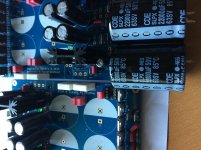Looks like a very cool power supply, impressive ripple specs!
Any info on the power supply impedance?
Any info on the power supply impedance?
The SLB is designed for Class A where the max current needed is always flowing. I don’t think impedance matters as much here like regulated PSU’s for Class AB Amos that may be called upon to open a pass transistor from near zero max. However, it does have a Toshiba audio grade power BJT for the Pass element set up in a CFP topology. So basically like a high speed power amp stage. I would expect impedance to be quite low.
There are more SLBs left in case anyone is interested. Great PSU for typical 25w Pass Class A amps like M2 or M2X, F3/F4/F5/F6/Aleph etc, or even USSA5, Hiraga, JLH. Certainly Alpha 20, Alpha BB, MoFo, etc.
Good morning from the hotter than hades east cost of USA.
I have my SLB boards mostly populated and have a question concerning the bulk CRC caps. Would 22,000 uF be ok to use? I have a stock of them that I would like to press into service. If these are ok I may just have a pair of aleph j amps running this weekend.
Thanks,
Evan
I have my SLB boards mostly populated and have a question concerning the bulk CRC caps. Would 22,000 uF be ok to use? I have a stock of them that I would like to press into service. If these are ok I may just have a pair of aleph j amps running this weekend.
Thanks,
Evan
Attachments
They will work, assuming they fit the lead spacing. The only concern is that there will be higher ripple currents and they may get too hot. Mostly of concern for the first caps right off of the rectification.
They definitely fit. Higher ripple current is my concern but I have no idea how the 1.5x uF rating will equate to ripple current and heating.
Since the Aleph J only runs at 1.25A and even if you used one for stereo at 2.5A, that’s half the design current of 5A so the max ripple current should still be ok. Keep an eye on the temperature of the first cap. Make sure it’s not too hot. Even though they are rated 85C, for long life they should run no more than half that so keep below about 45C. Bit even if they ran hotter it just means replacing sooner than later.
Thanks for the answers. I’ll be building two mono amps so it seems like I’ll by ok. I’ll pay attention to the temp when the amps get up and running.
These boards are beautiful. Well laid out and thoughtful on the inclusion of lots of ground returns, the loop breasted for the chassis return and transformer snubber.
A side note is that a large chisel tip was definitely needed to get a good solder flow to the ground plane.
These boards are beautiful. Well laid out and thoughtful on the inclusion of lots of ground returns, the loop breasted for the chassis return and transformer snubber.
A side note is that a large chisel tip was definitely needed to get a good solder flow to the ground plane.
Yes, I use a 60w iron with a fat chisel tip set at 350C. That’s the only way to flow solder on these boards.
It might be useful to have your circuits guru read through the ripple current rating section of Nichicon's Applications guidelines for aluminum electrolytics (3 pages attached below -- the full doc is too big to attach).
Remember that in a mainstrafo-->rectifier-->caps circuit, the ripple frequency is 120 Hz so your calculations use tan_delta (dissipation factor), NOT the high frequency "ESR" spec that's provided for high frequency SMPS applications. Most electrolytic capacitor datasheets tell you the tan_delta AND the derating vs capacitance: see blue arrowhead.
_
Remember that in a mainstrafo-->rectifier-->caps circuit, the ripple frequency is 120 Hz so your calculations use tan_delta (dissipation factor), NOT the high frequency "ESR" spec that's provided for high frequency SMPS applications. Most electrolytic capacitor datasheets tell you the tan_delta AND the derating vs capacitance: see blue arrowhead.
_
Attachments
Not sure why you are referencing the Nichicon datasheet. The BOM specifies a CDE 15,000uF 50v cap with 6.5A ripple current spec’d at 120Hz per the requirements defined by the LTspice simulation.
SLPX153M050H4P3 Cornell Dubilier - CDE | Mouser
SLPX153M050H4P3 Cornell Dubilier - CDE | Mouser
More as a caution to member evanc who proposes to use his existing stock of SLPX223M050H9P3 capacitors as substitutes.. Run the numbers and decide: comfortable? / nervous? / certainfailure? (That part number is just a guess based on the markings visible in the photo. Check against the invoice or shipping bag that evanc received, for the definitive not-a-guess part number)
_
_
Evanc has same Cornell Dubelier Electronics (CDE) SLPX 50v (photo clearly says CDE SLPX) but next size up at 22,000uF.
CDE caps
The 22000uF caps can handle 1.4 Amperes more ripple than the 15000uF ones, but have an ESR of 16 mOhms compared to 23 mOhms. And they're slightly cheapper than the 15000 uF ones. There shouldn't be a problem?
My 2c worth.
Evanc has same Cornell Dubelier Electronics (CDE) SLPX 50v (photo clearly says CDE SLPX) but next size up at 22,000uF.
The 22000uF caps can handle 1.4 Amperes more ripple than the 15000uF ones, but have an ESR of 16 mOhms compared to 23 mOhms. And they're slightly cheapper than the 15000 uF ones. There shouldn't be a problem?
My 2c worth.
https://www.mouser.com/datasheet/2/88/SLPX-32478.pdf
Looks like my part is rated at 7.89A @ 120hz.
I’m all for being careful with part selection but am unsure on how to math out this one. In this case I’m ok with letting intuition rule and checking the parts in use.
Thanks
Evan
Looks like my part is rated at 7.89A @ 120hz.
I’m all for being careful with part selection but am unsure on how to math out this one. In this case I’m ok with letting intuition rule and checking the parts in use.
Thanks
Evan
- Home
- Group Buys
- The SLB (Smooth Like Butter) Active Rect/CRC/Cap Mx Class A Power Supply GB

 Thanks for taking all the time to do this for us X!
Thanks for taking all the time to do this for us X!
